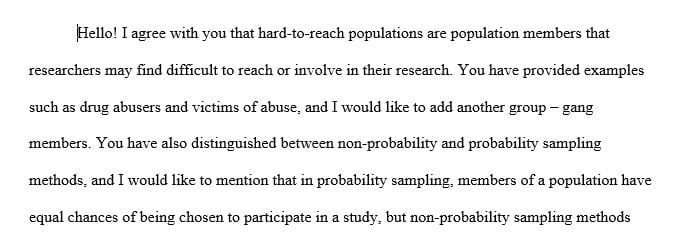Hard-to-reach is a term used to describe those sub-groups of the population that are difficult to reach or involve in research or public health programs
Response Prompt:
You must also post a 100-200 word response to at least one peer. In these posts, respond as if you were dialoguing in response to their initial post. Your response should add a new perspective, share new information or pose a critical thinking question. Your response should not be a simple “I agree with you” or “I found that interesting”.
Prior to submitting your posts, check them for appropriate grammar, spelling, and formatting. Your discussion posts must include at least 2 professional references to receive full credit. Professional references can include the textbook(s), assigned readings and resources, as well as appropriate government, organizational, or professional publications, reports and websites.
this is the peer I have to respond 200 words to it
According to Shaghaghi et al., “Hard-to-reach is a term used to describe those sub-groups of the population that are difficult to reach or involve in research or public health programs due to their physical and geographical location (e.g. in mountains, forests or deserts) or their social and economic situation” (2011, p. 86). Some examples of hard to reach populations would be individuals who are homeless, abuse victims or substance abusers. When sampling a population, there are two types of sampling methods: Probability and Non-Probability. Each method identifies units from which the sample of the population will be drawn also known as the sampling frame. In a Probability Sampling there is an equal chance for each unit to be picked in the evaluation, while in the Non-Probability sampling each unit does not have an equal chance of being picked for the evaluation (Grinnell et al., 2019, p. 312 & 313). If I were to conduct a study on substance abusers, I would likely use a “Snowball Sampling” method. This method involves locating a small sample and after data is collected from an individual, they are asked to identify others within the population and interviews are conducted until the desired sample size is obtained (Grinnell et al., 2019, p. 313). This would be beneficial as many people may not be willing to come forward for an interview but may be more receptive if they knew of someone who had participated. The strategy that I would likely use would be a Structured One-on-One interview with the individual. The conversation via a face-to face interaction may ease some feelings of apprehension, while the structured questions assure that the same data is being collected from each person.
References
Grinnell, R. M., Gabor, P., & Unrau, Y. A. (2019). Program evaluation for social workers: foundations of evidence-based programs (8th Edition). Oxford University Press.
Shaghaghi, A., Bhopal, R.S., & Sheikh, A. (2011). Approaches to recruiting “hard-to-reach” populations into research: A review of the literature. Health Promotion Perspectives, 1 (2), 86-94. Published online 2011 Dec 20. doi: 10.5681/hpp.2011.009
Answer preview to hard-to-reach is a term used to describe those sub-groups of the population that are difficult to reach or involve in research or public health programs
APA
238 words


